The Whale Keepers of San Ignacio, Mexico
Article and photos by James
Michael Dorsey
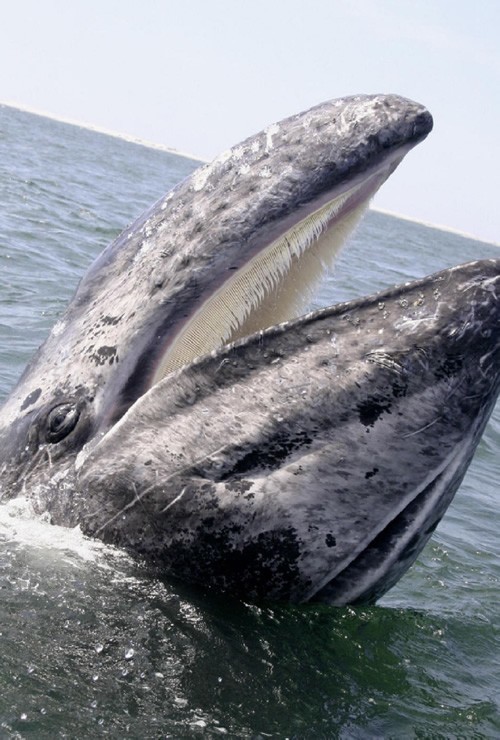
|
|
Laughing Pacific Grey Whale near San Ignacio, Mexico.
|
The first written reference to whales is in Genesis, chapter one, verse 21, of the King James Bible. According to the story of Creation, it is written, “And God created the great whales.” The Vikings, Scandinavia's great early seafarers were possibly among the earliest whale watchers, as the Icelandic sagas tell of sea monsters spouting fire from the tops of their heads, which could only have been the blows of whales. Chinese mariners, looking for the new world long before Columbus, wrote about fire-breathing sea creatures. Whales preceded mankind on earth.
* * * * *
Whales have returned again and again to their preferred geographic locations since before recorded history, summoned by an inner call heard by no one.
They will swim 6,000 to 7,000 miles to arrive at their destination, braving predators and bearing their young along the way. The annual journey of the Pacific Gray Whale is among the most ancient and epic migrations on earth, and has resulted in forging a unique symbiotic relationship between man and beast.
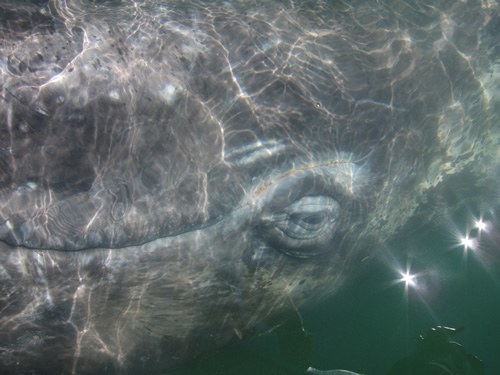
|
|
Whales are not shy to come up very close to the whale keepers and their guests.
|
San Ignacio Lagoon is part of the massive Vizcaino Biosphere, a protected area that encompasses almost a quarter of Mexico’s Baja Peninsula, and its salt-rich waters are the only place on this earth where wild animals in their natural habitat routinely seek out human contact. It is even more amazing that these animals — who can reach 40 feet in length and weigh almost 40 tons — were hunted almost to extinction less than a century ago, and now come to man in friendship. As the nursery of the Pacific Gray Whale, San Ignacio is one of three small Mexican lagoons where this miracle takes place.

|
|
Vizcaino Biosophere.
|
Of the current stock of Gray Whales, numbering somewhere near 20,000 creatures, almost 10% make an annual round trip migration to the lagoon. Along their route, they bear their calves before returning to the arctic waters of the Bering and Chuksi seas. Born with almost no natural instincts, Gray Whale babies must be taught everything, including how to swim and eat. If the mother dies before the calf is weaned, at about eight months, the baby will most likely die. The mothers are also not known to adopt orphans. In the lagoon, mother whales will spend four to six weeks teaching their calves how to be whales in order to prepare them for the return swim to their summer feeding waters. It is a cram course in survival, but equally amazing are the people that watch over the species.
The lagoon is home to less than 600 full-time residents. They are fishermen, as were their fathers before them, and so on before recorded history. They are an ancient people, descendants of the Cochimi, who as nomadic hunter/gatherers drove back invading Spanish armies that conquered mainland Mexico but never Baja. The fishermen derive their living from the ocean. In turn, they have devoted their lives to saving it along with its creatures. To them, the whales are not just a source of income, but family, since just like their ancestors, the residents of San Ignacio learned long ago to exist in harmony with the land and creatures that surround them, knowing that no one living creature is more important than another.
From the time the Mexican lagoons were discovered in the mid-19th century by a San Francisco whaler named Charles Scammons, Gray Whales were called “Devil Fish.” Labeled as killers because they fought back when their calves were harpooned, they were hunted to the brink of extinction until they were saved by the Second World War. Besides the United States, the other great whaling nation of that time was Japan, and with these two industrial giants busy killing each other for the next six years, whaling was put on hold. With this respite, Gray Whales made a miraculous comeback. But after the war, the slaughter continued until 1972 when the United States initiated the Marine Mammal Protection Act. Even with this shield in place, several nations continued to hunt whales until Mexico created the Vizcaino Biosphere in 1988, a 9,625 sq. mile (370,950 hectares) haven with the lagoon at its center. (Many nations have found ways to continue whaling to this day.)
The story goes that in 1970 a local fisherman named Pacheco Mayoral was alone in his boat when a Gray Whale approached it. He cowered in the hull for some time before venturing to look over the side to see a very large eye staring at him. Summoning his courage, Pacheco reached out to touch the whale and to his surprise found it responding to his hand. Lagoon residents claim this as the start of modern day whale watching, and who is to dispute the story? But for residents the relationship is not one of mere “watching.” These animals are their friends, their family, and their livelihood.
From April through December the men of the lagoon fish from small open boats called pangas. (20-foot open boats.) They use only hand lines to routinely do battle with 50-300 pound fish, sometimes venturing miles outside the shelter of the lagoon into the open ocean. On land, during low tide, they catch clams, scallops, and octopus from the shallows of this fertile place. Some of them use hookah rigs to dive for scallops in shallow water. The men are some of the finest old school mariners on earth. Each December they put away the hand lines and take to the pangas in order to shuttle people out onto the water to interact with the largest living creatures on earth. No better animal experts exist anywhere.
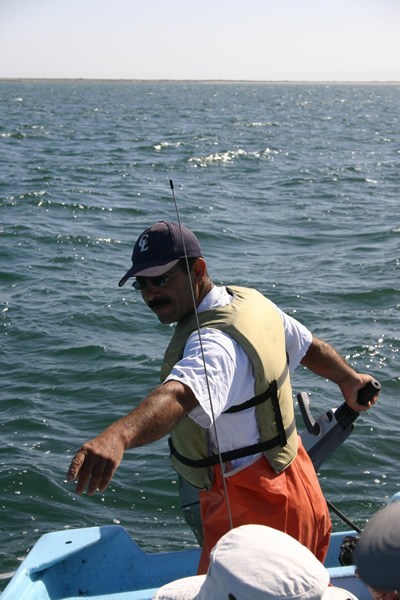
|
|
A pangadero working on a panga boat.
|

|
|
A catch of a huge scallop.
|
Each animal has its own comfort zone, so the boats do not approach closely; instead, they cut their engines and allow the whale to approach them. Mothers will bring their calves to be petted, sometimes lifting them from below, sometimes supporting them with a pectoral fin. Often they come with open mouths to have their tongue and baleen stroked as they actively seek out human touch. When babies tire, mothers will place them on their backs, allowing them to sleep for a few minutes. They will scan the horizon, estimate the time it would take for a predator to reach them, and that is exactly how long they will allow the calf to sleep, but no longer, using an inbred clock that has helped them to survive for millennia. Mothers will stand on their tail flukes directly next to a boat to be petted, going from person to person until all have laid hands on them. They will bring their enormous heads out of the water and look at any humans present eye to eye. During such interspecies communication, emotions run high. It is common for people to cry when first touching a whale.
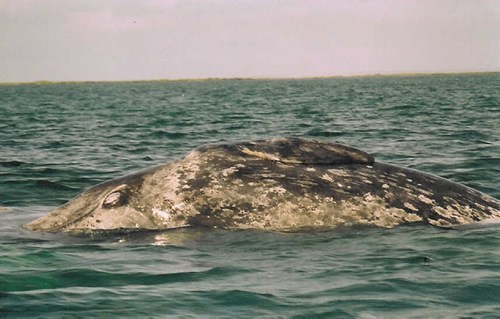
|
|
Baby whale asleep on mother near San Ignacio, Mexico.
|
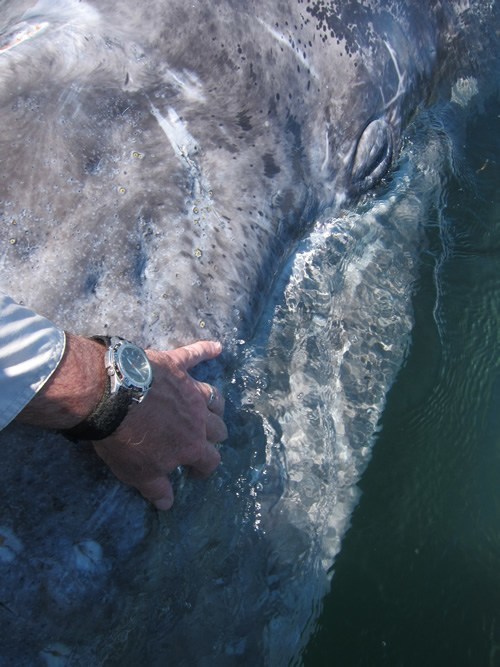
|
|
A pangadero working on a panga boat.
|
Approaching boats is a learned behavior passed on from mother to calf. As the same whales return each year, the pangaderos identify them from coloration, scarring, and even personal behavior. Some have formed bonds with the whales, naming them and ascribing particular traits and idiosyncrasies to individuals. Whales have been known to seek out the same boats and drivers year after year proving their intelligence and giving insight into their thought processes.
So Who are these Whale Keepers?
Whale keepers care little for modern trappings but are open to technology that serves their purpose. They are hardy people who have adapted to a harsh land and made of it a fine home, living by the cycles of nature. They are quick to laugh, and many produce art and music as easily as most of us breathe. They see the beauty of nature all around them. The whale keepers' lives have changed little since the days of their forefathers since they believe they are living in paradise, and see no need for what most call progress. Their small homes are hand built, sometimes from the detritus offered up by the ocean. The whale keepers seek simplicity in their lives. They incarnate the ingenuity necessary for life in an isolated land, where it is imperative to have many skills just to survive. The tiniest need of any individual inhabitant brings the entire community running to help.
The whale keepers are people of honor who have given their word to perpetuate the Grey Whale species, and in so doing have turned their backs on enormous amounts of money offered by corporate greed mongers who wish to build industrial plants and grotesque tourist resorts on the land. Allowing commercial resorts would, of course, end one of the oldest migrations in existence. So each year, as the offers from foreign corporations grow in size, the fishermen vote no since for them it is all about the whales.
There are few enough instances when a handful of determined people have stood in the path of advancing greed and said, "Not on my watch." The whale keepers of San Ignacio have been doing so for generations.
Throughout history there have been unique stories about bonds between humans and wild animals. Most have been single occurrences, one of a kind encounters, or inexplicable anomalies. Only in this speck of a lagoon near the southern tip of Mexico do wild creatures and human beings routinely seek each other out in friendship.
James Michael Dorsey is
an explorer, award winning author, photographer, and
lecturer. He has traveled extensively in 45 countries,
mostly far off the beaten path. His main pursuit
is visiting remote tribal cultures in Asia
and Africa.
|
